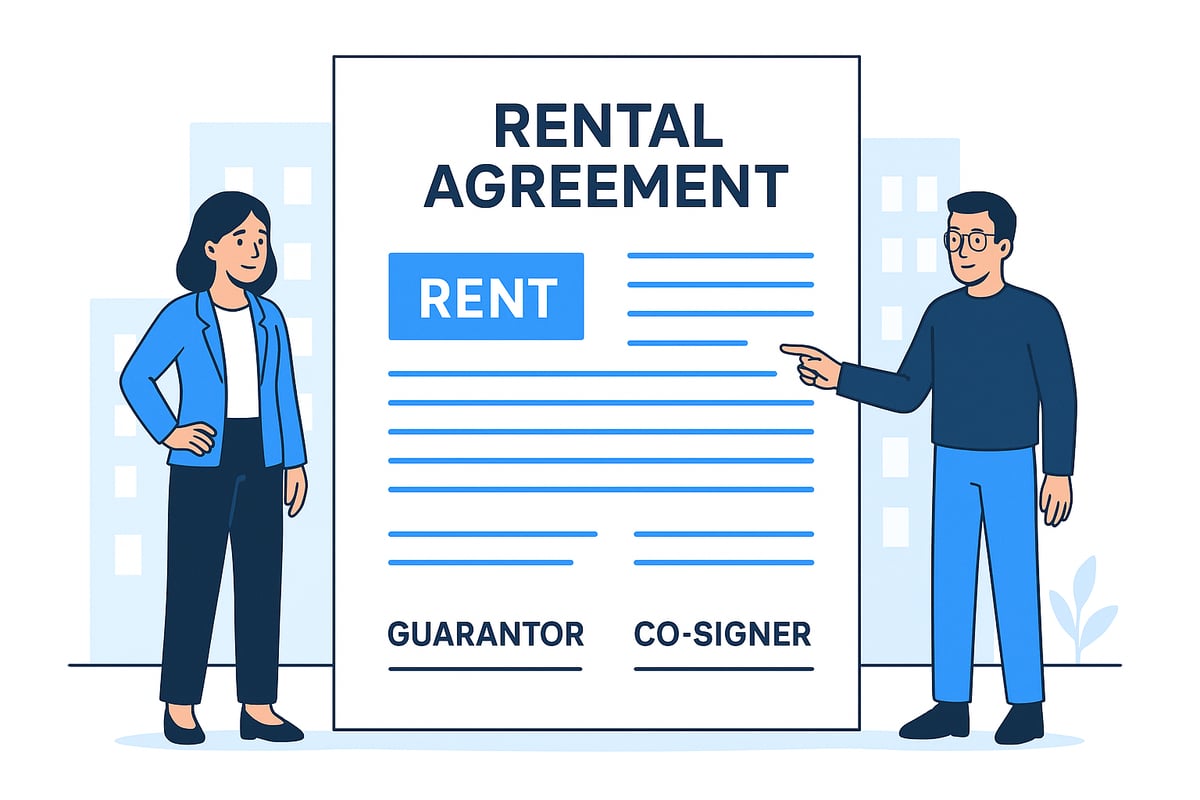Guarantor Guide: Everything You Need to Know in 2025
Imagine you finally find the perfect apartment or secure that long-awaited loan in 2025, only to discover a guarantor is required. What does this mean for your financial journey?
In this guide, you will gain clarity on every aspect of the guarantor process. We break down their responsibilities, legal implications, and the practical steps you need to take.
You will learn how guarantors differ from co-signers, who qualifies, what documentation is essential, and the risks involved. With expert insights, this guide will help you approach approvals with greater confidence and ease.
What is a Guarantor? Definition and Role in 2025
A guarantor is a person or entity who legally agrees to take responsibility for someone else’s financial obligations if that person fails to meet them. In simple terms, if you cannot pay your rent or loan, your guarantor steps in to cover the debt. For a deeper dive into related terminology, see the Financial terms glossary.
The role of a guarantor has become increasingly vital in 2025, especially for those navigating competitive urban rental markets or applying for loans with limited credit history. Landlords, lenders, and service providers often require a guarantor as a form of security. It provides reassurance that payments will be made even if the original applicant encounters financial trouble.
Today, the need for a guarantor is especially common among recent college graduates moving to major cities, self-employed individuals without a traditional income stream, or international students new to the country. These groups may not have enough credit or financial history to qualify on their own.
Who Typically Needs a Guarantor in 2025?
| Scenario | Why a Guarantor Is Needed |
|---|---|
| College graduate renting in NYC | Limited credit or rental history |
| Self-employed applying for a loan | Non-traditional income sources |
| International student | No local financial track record |
| Young professional in tech hub | High rent, competitive applicants |
Recent data shows that in 2025, up to 40% of urban rental applications require a guarantor. This figure reflects stricter lending standards and increased competition for prime properties. In hot markets, having a guarantor can make the difference between securing your ideal home and missing out.
Digital innovation has also transformed how guarantors are screened and agreements are managed. Online platforms allow landlords and lenders to verify income, run credit checks, and collect signatures electronically. This streamlines the process, making it faster and more secure for all parties involved.
For landlords and lenders, a guarantor acts as a financial safety net, reducing the risk of unpaid debts. For tenants and borrowers, having a guarantor can open doors to housing or financing that might otherwise be out of reach. Ultimately, the presence of a guarantor offers peace of mind to everyone, ensuring that obligations will be met, even in uncertain times.

Guarantor vs. Co-Signer: Key Differences Explained
Navigating financial agreements in 2025 often means encountering both the terms "guarantor" and "co-signer." Though sometimes used interchangeably, these roles carry distinct responsibilities and risks. Understanding their differences is essential for anyone applying for a lease or loan, as the choice can significantly impact your liability and approval odds.

Definitions and Legal Distinctions
A co-signer is someone who joins the primary applicant on a financial contract from the very beginning. This means both the co-signer and the applicant share equal responsibility for payments, and both may face legal actions if obligations are not met. In contrast, a guarantor is only called upon if the primary party defaults. The guarantor does not typically sign the original contract but agrees to cover missed payments or damages if the applicant fails to do so.
Legally, the co-signer's obligations are immediate, while the guarantor's role is secondary. This distinction affects when each party is contacted and the extent of their financial risk. The keyword "guarantor" is especially important in contracts where the lender or landlord seeks extra security but does not want to grant occupancy rights.
Comparison Table: Co-Signer vs. Guarantor
Below is a summary table to clarify the practical differences:
| Feature | Co-Signer | Guarantor |
|---|---|---|
| Liability | Immediate and ongoing | Only if primary defaults |
| Occupancy Rights | May have rights to occupy | No occupancy rights |
| Contract Party | Signs main agreement | Separate guarantee agreement |
| Credit Impact | Affected by all payments | Affected only if called upon |
| Legal Recourse | Action taken against either party anytime | Action taken after default only |
This table shows how the co-signer and guarantor differ in liability, contract status, and exposure to risk.
Example Scenario and Lease Language
Consider a missed rent payment. The landlord contacts the co-signer immediately, since both are liable from day one. For a guarantor, the landlord first pursues the primary tenant. Only if the tenant fails to pay does the landlord turn to the guarantor for the outstanding balance.
Lease agreements must clearly define these roles. Some contracts, especially in 2025, blur the lines and treat both as equally liable unless specified. As noted by LeaseRunner, ambiguous language can cause confusion, so always read the agreement carefully and clarify your status before signing.
Insights for 2025: Evolving Legal Frameworks
In 2025, legal distinctions between guarantor and co-signer are evolving. Landlords and lenders increasingly rely on clear, digital agreements and third-party screening platforms. Some jurisdictions are updating laws to further differentiate or align these roles, affecting the rights and obligations of each party. For more on how recent legal changes affect guarantor responsibilities, see this resource on legal responsibilities of corporate guarantors.
Understanding the difference between a co-signer and a guarantor can help applicants choose the right support, avoid unexpected risks, and secure their housing or loans with greater confidence.
Who Can Be a Guarantor? Qualifications and Requirements
Securing a guarantor is a crucial step for many in 2025, especially when navigating strict rental and loan approval processes. But who exactly qualifies as a guarantor, and what standards must they meet? Understanding these criteria can make the difference between a smooth application and a frustrating denial.

Minimum Requirements for Becoming a Guarantor
To be eligible as a guarantor, an individual must generally be at least 21 years old and a legal resident of the country where the contract is enforced. Verifiable identity is mandatory, so government-issued identification is a standard requirement. Residency status is also important, as many landlords and lenders require the guarantor to reside within the same country or even the same state as the applicant.
A guarantor must have a clear legal standing, without recent bankruptcies or legal restrictions that could limit their ability to fulfill obligations. Employers, family members, or close friends are common choices, but professional guarantor services are also becoming more popular.
Financial Qualifications: Income and Credit Standards
Financial stability is the foundation of a strong guarantor application. Typically, a guarantor must show an income that equals 80 to 100 times the monthly rent or a comparable amount for loans. This high threshold provides assurance to landlords and lenders that the guarantor can cover payments if needed.
Creditworthiness is equally vital. Most require a credit score of 700 or above, with a history free of recent delinquencies or defaults. Lenders and landlords may also look at other financial metrics, such as the debt-to-equity ratio basics, to assess overall financial health and risk.
Required Documentation for Guarantors
The documentation process is comprehensive. To verify eligibility, a guarantor must provide:
- Recent pay stubs and tax returns to confirm income
- Bank statements showing sufficient reserves
- Government-issued identification (passport or driver’s license)
- References from employers or financial institutions
Some landlords or lenders might request additional documents, such as proof of residency or credit reports, especially in competitive markets.
Restrictions: Who Cannot Be a Guarantor?
Not everyone is eligible to act as a guarantor. Individuals with poor credit history, insufficient income, or unresolved legal issues are typically disqualified. Many landlords also restrict guarantors to those residing within specific geographic regions.
Legal limitations may also apply. For example, minors, non-residents, or parties with conflicts of interest are usually not accepted. Ensuring all requirements are met can prevent delays or rejections during the application process.
Real-World Examples
Consider a parent acting as a guarantor for a college student renting their first urban apartment. The parent meets age, residency, income, and credit requirements, and provides all necessary documentation. Alternatively, an employer might serve as a guarantor for an employee relocating for work, offering an extra layer of financial assurance to the landlord.
Understanding these qualifications helps applicants select the right guarantor and prepare a thorough, compliant application.
The Legal and Financial Responsibilities of a Guarantor
Becoming a guarantor is a significant legal and financial commitment. When you agree to serve as a guarantor, you promise to step in if the main party defaults on their obligations. This means you are not just offering moral support; you are putting your own finances and credit reputation on the line.

Legal Obligations
The core responsibility for any guarantor is to pay what the primary party owes if they cannot. This could include unpaid rent, damages to a property, or missed loan payments. For example, if a tenant fails to pay $3,000 in rent, the guarantor is legally required to cover that amount.
A guarantor’s duties are defined by the agreement they sign. These legal documents specify exactly what the guarantor is responsible for, including any fees, penalties, or additional charges that may arise. The specifics vary by contract, so it is crucial to read every clause carefully.
Duration, Documentation, and Consequences
A guarantor’s liability usually lasts for the full term of the lease or loan, plus any renewals or extensions that are agreed upon. Some agreements even include automatic renewal clauses, which can extend responsibility unless the guarantor formally withdraws.
To formalize the arrangement, landlords and lenders require signed guarantor agreements, lease addenda, or loan contracts. These documents must be clear about the scope and duration of the commitment. If the primary party defaults, the guarantor faces serious consequences, including negative marks on their credit report, potential lawsuits, and collection actions.
In the context of loans, a default may result in the loan being classified as a non-performing loan, which directly triggers the guarantor’s obligations. This can have long-term financial effects.
Rights, Protections, and Risks
While the guarantor takes on substantial risk, there are some protections in place. Most agreements require that the guarantor be notified promptly if the primary party misses a payment or otherwise defaults. This gives the guarantor a chance to address the issue or contest any disputes.
The risks can be significant. If you are a guarantor, your own debt-to-income ratio may be affected, potentially making it harder to qualify for new loans. In the event of default, you could be responsible for large sums, and your credit score may suffer.
Here is a quick summary of key risks and protections:
| Risk/Responsibility | Details |
|---|---|
| Financial Exposure | Pay unpaid rent, damages, or loan balances |
| Credit Impact | Possible negative marks on credit report |
| Legal Action | Subject to lawsuits or collections |
| Notification Rights | Right to be informed of any default |
| Dispute Resolution | Ability to contest charges |
Before agreeing to be a guarantor, it is essential to weigh both the legal and financial responsibilities. Seek legal advice if you are unsure, and always keep copies of all documents for your records.
Essential Documents and Screening for Guarantors
Securing a rental or loan in 2025 typically involves a thorough guarantor screening process. This step protects both parties, ensuring the guarantor is financially able and legally fit to step in if needed. Comprehensive documentation and careful evaluation are now standard in today’s competitive market.
Required Documents for a Guarantor
Landlords and lenders require several key documents to assess a guarantor. These typically include:
- Recent pay stubs (to verify steady income)
- Tax returns (usually for the past two years)
- Bank statements (to confirm available funds)
- Government-issued identification (such as a passport or driver’s license)
- Professional or personal references
For example, a strong guarantor profile might show $8,000 per month in income, $15,000 in liquid assets, and a 750 credit score. These documents provide a clear financial snapshot.
Credit and Background Screening
A guarantor’s credit report is critical. Most landlords and lenders require a minimum credit score of 700, with no recent delinquencies or bankruptcies. In addition, background checks are standard. These checks screen for:
- Criminal history
- Prior evictions
- Outstanding legal judgments
Some organizations also use underwriters, who specialize in evaluating risk and verifying the accuracy of guarantor documentation. Learn more about the role of an underwriter in financial agreements.
Digital Platforms and Compliance
The rise of digital platforms in 2025 has made collecting and verifying guarantor documents faster and more secure. Applicants can now upload files, consent to background checks, and sign agreements electronically. Data privacy is essential, with secure storage and explicit consent required at every step. Landlords must also follow compliance rules such as providing adverse action notices and guarantors if an application is denied based on screening results.
Red Flags and Recordkeeping
Certain red flags can disqualify a guarantor, including inconsistent income, unverifiable documents, or a history of poor credit. Landlords and lenders must keep thorough records of all screening materials and communications. This documentation is crucial for legal recourse if disputes arise later.
Proper screening and documentation not only protect the landlord or lender but also ensure that the guarantor understands their responsibilities from the outset.
Challenges, Risks, and Alternatives to Using a Guarantor
Navigating the guarantor process in 2025 can present several obstacles for tenants, landlords, and even the guarantors themselves. Understanding these challenges and knowing alternative solutions can help you make informed decisions, prevent misunderstandings, and reduce financial risks.
Common Challenges for All Parties
Securing a guarantor is often easier said than done. Many applicants struggle to find someone with the financial stability and willingness to accept responsibility. Family and friends may hesitate due to the potential risks involved.
Communication breakdowns can occur when expectations are not clearly set. For instance, some guarantors may not fully understand their obligations or the duration of their commitment. This confusion can lead to disputes if the primary applicant defaults.
Landlords and lenders face their own hurdles. Verifying a guarantor's financial credentials and ensuring their legal enforceability can be complex. In some cases, agreements may not hold up in court, especially if they lack proper documentation or clear terms. The Enforceability of personal guaranties during COVID highlighted how rapidly changing laws can complicate enforcement, making it critical to stay informed.
Risks for Guarantors, Tenants, and Landlords
The guarantor role carries significant financial exposure. If the primary party defaults, the guarantor may be held liable for large sums, which can affect their credit score and increase their debt-to-income ratio. Legal action is a real possibility if payments are missed or obligations are disputed.
Tenants also face risks. Without a qualified guarantor, they may lose out on a dream apartment or essential loan. Some may settle for less favorable terms or pay higher upfront costs to compensate.
For landlords and lenders, relying on a guarantor can backfire if the agreement proves unenforceable or if the guarantor's financial situation changes unexpectedly. Delays in payment or lengthy legal proceedings can disrupt operations.
Alternatives to the Traditional Guarantor
When using a guarantor is not feasible, several alternatives can bridge the gap:
| Alternative | Description | Typical Cost/Requirement |
|---|---|---|
| Guarantor waiver fee | One-time payment replacing need for a guarantor | $500+ upfront |
| Higher security deposit | Larger refundable deposit to offset risk | 1.5–2x standard deposit |
| Rent insurance | Policy covers missed rent payments | Monthly premium |
| Professional guarantor service | Third-party company acts as guarantor for a fee | Annual or monthly fee |
| Co-signer | Person shares full responsibility from start | Subject to same screening |
For example, many tenants in competitive cities now opt to pay a $500 guarantor waiver fee instead of securing a traditional guarantor. This option provides flexibility and speeds up approvals, though it may increase upfront costs.
Legal Considerations and Dispute Resolution
Local laws may restrict the amount or use of waiver fees and require full disclosure of all terms. Compliance is vital for both landlords and tenants. Carefully review all agreements and consult legal advice if needed.
If a default or disagreement arises, open communication is key. Document all conversations and payments, and be proactive in seeking solutions. Mediation or legal counsel may help resolve complex cases.
Understanding the challenges, risks, and alternatives to using a guarantor empowers all parties to make choices that best fit their financial situation and goals.
Understanding guarantors in 2025 is just the start—you’ve now seen how legal and financial responsibilities, digital screening tools, and evolving market trends can shape your next rental or loan experience. If you want to dive deeper and see how these changes fit into the bigger picture of financial markets, you can join a platform designed to make sense of history’s impact on today’s decisions. Explore interactive charts, AI-powered insights, and original reporting that connect the dots between past and present. Ready to bring context to your financial journey? Join Our Beta
